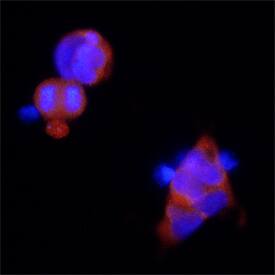Human SARM1 Antibody
R&D Systems, part of Bio-Techne | Catalog # MAB7037

Key Product Details
Species Reactivity
Applications
Label
Antibody Source
Product Specifications
Immunogen
Lys556-Thr724
Accession # Q6SZW1
Specificity
Clonality
Host
Isotype
Scientific Data Images for Human SARM1 Antibody
SARM1 in HEK293 Human Cell Line.
SARM1 was detected in immersion fixed HEK293 human embryonic kidney cell line using Mouse Anti-Human SARM1 Monoclonal Antibody (Catalog # MAB7037) at 25 µg/mL for 3 hours at room temperature. Cells were stained using the Northern-Lights™ 557-conjugated Anti-Mouse IgG Secondary Antibody (red; Catalog # NL007) and counterstained with DAPI (blue). Specific staining was localized to cytoplasm. View our protocol for Fluorescent ICC Staining of Cells on Coverslips.Applications for Human SARM1 Antibody
Immunocytochemistry
Sample: Immersion fixed HEK293 human embryonic kidney cell line
Formulation, Preparation, and Storage
Purification
Reconstitution
Formulation
Shipping
Stability & Storage
- 12 months from date of receipt, -20 to -70 °C as supplied.
- 1 month, 2 to 8 °C under sterile conditions after reconstitution.
- 6 months, -20 to -70 °C under sterile conditions after reconstitution.
Background: SARM1
SARM1 (Sterile alpha and TIR motif-containing protein 1; also SAM domain-containing protein 2 and TIR-1 homolog) is a 73-75 kDa member of the TLR adaptor family of molecules. It is both nuclear and cytoplasmic, and expressed in monocytes, neurons, and retinal photoreceptor cells, where it demonstrates disparate activities. In monocytes, SARM1 is a specific inhibitor of TRIF-dependent TLR-3 and -4 signaling, and appears to block MAPK phosphorylation. In neurons, SARM1 regulates microtubule stability, and thus axon and dendrite elongation. And in retinal photoreceptor cells, SARM1 complexes with Na/K ATPase to create a cell surface receptor for retinoschisin. Human SARM1 is 724 amino acids (aa) in length. It contains an N-terminal polybasic motif (aa 1-20) and a Gly-rich region (aa 22-90) that may anchor the molecule to intracellular membranes. It also possesses two SAM domains (aa 412-548) plus a TIR region (aa 559-657) that appears to interact with TIRF. Proteolytic cleavage products of 35 kDa and 30 kDa have been described. There is one splice variant that shows a 72 aa substitution for aa 1-106. Over aa 556-724, human SARM1 shares 94% aa identity with mouse SARM1.
Long Name
Alternate Names
Gene Symbol
UniProt
Additional SARM1 Products
Product Documents for Human SARM1 Antibody
Product Specific Notices for Human SARM1 Antibody
For research use only
